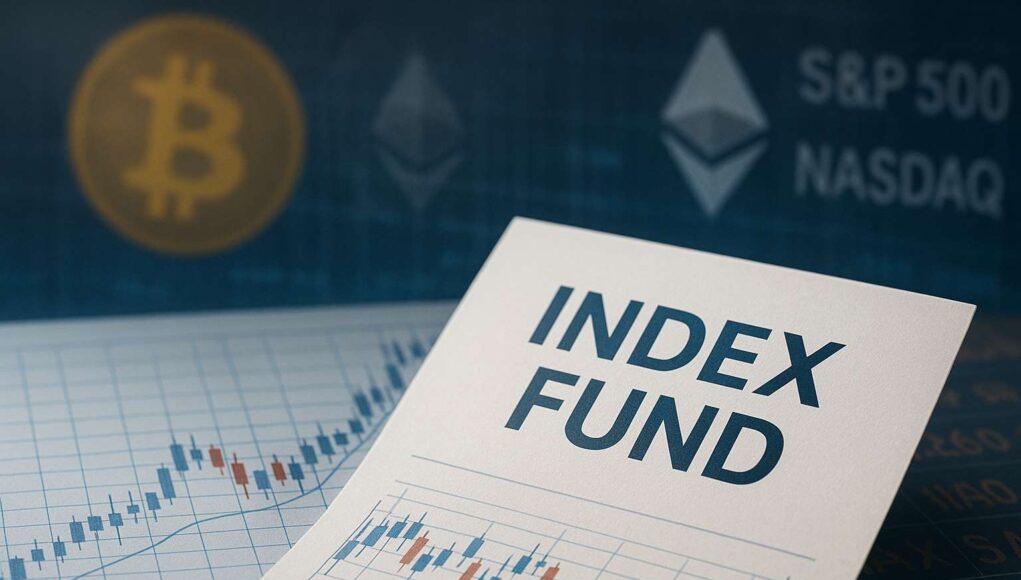How Crypto Creeps into Your Portfolio Without You Noticing
You might believe you’ve successfully avoided cryptocurrency investments. After all, you haven’t bought Bitcoin, you don’t hold Ethereum, and you’ve skipped every crypto exchange account opening. Yet, if your retirement savings sit in index funds tracking the S&P 500, Nasdaq, or MSCI World, chances are you already have indirect crypto exposure via index funds, whether you intended to or not.
Passive investors relying on diversified index-tracking ETFs and mutual funds are increasingly finding themselves exposed to companies deeply involved with crypto, from Bitcoin-holding corporates like Tesla to crypto-native firms like Coinbase. As crypto quietly infiltrates mainstream financial indexes, retail investors must ask themselves: Do I still have control over my investment strategy?
How Crypto Is Creeping into Mainstream Indexes
Key Companies Driving Indirect Exposure
The creeping exposure begins with specific companies embedded in major stock indexes. Some of the biggest names include:
- Coinbase (COIN): Now part of both the S&P 500 and Nasdaq-100, Coinbase is the most direct crypto exposure retail investors hold passively today. As the leading U.S. crypto exchange, it ties index funds directly to the fortunes of the crypto market.
- Tesla (TSLA): Beyond being an electric vehicle icon, Tesla holds over $1.25 billion in Bitcoin, making it a major corporate holder of cryptocurrency.
- MicroStrategy (MSTR): Best known today for turning itself into a quasi-Bitcoin ETF, MicroStrategy’s stock performance largely tracks Bitcoin’s price, though it’s classified as a software company in indexes like MSCI.
- Block (formerly Square), PayPal, Nvidia, Visa, Mastercard, JPMorgan: These firms engage with crypto through services, partnerships, or indirect exposure to blockchain and Web3 technologies.
Index Inclusion Mechanics
Indexes like the S&P 500 or MSCI World aren’t curated for crypto neutrality. They select stocks based on market cap, liquidity, and other financial metrics, not business lines. When a company like Coinbase meets those standards, it’s included, and index-tracking funds are obligated to hold it. For investors in passive vehicles like ETFs or mutual funds, this is automatic exposure. No choice required.
>>> Read more: SharpLink’s $1B Ethereum Bet: Stock Soars on Treasury Shift
The Scale of Exposure: How Much Crypto Is in Your ETF?
ETF Examples and Crypto Weights
| Fund Type | Crypto-Related Holdings | Estimated Exposure |
|---|---|---|
| S&P 500 ETFs | Coinbase, Tesla, PayPal, Block | < 1% total weight |
| Total Market ETFs | Adds MicroStrategy, crypto miners (e.g., Riot) | Slightly higher, still < 1% |
| Nasdaq-100 ETFs | Coinbase, Tesla, Nvidia, PayPal | < 1% |
| MSCI ACWI ETFs | U.S. names above, minor global crypto firms | Negligible |
Exposure remains tiny. Though it’s fractions of a percent in most cases, it’s real. For example, a $10,000 position in an S&P 500 ETF effectively holds about $11 worth of Coinbase stock. Vanguard’s index funds, despite their anti-crypto reputation, are now the largest shareholders of MicroStrategy, giving them indirect exposure to the company’s massive Bitcoin holdings.
Case Study: Vanguard’s Accidental Bitcoin Bet via MicroStrategy
Vanguard’s passive investing philosophy leads it to own 8% of MicroStrategy’s shares, translating into indirect holdings of billions of dollars’ worth of Bitcoin. This position arose not from a crypto bet but from tracking total market indexes. Even the world’s largest anti-crypto asset manager couldn’t escape Bitcoin.
Investor Sentiment: Awareness, Reactions, and Risks
Reactions from Investors and Advisors
- Crypto advocates see index fund inclusion as validation, proof that crypto is mainstream.
- Skeptics argue this exposes conservative investors to unnecessary volatility and risk.
- Financial advisors emphasize transparency: even passive investors need to understand what’s inside their funds.
For many, the scale is too small to worry about. For others, even a fraction of unintended exposure conflicts with their strategy.
Implications for Retail Investors
Passive investing means surrendering control. If your strategy is zero crypto, index funds now undermine that purity. ESG-conscious investors may turn to screened funds that exclude crypto-involved companies. Otherwise, the hidden crypto exposure in ETFs is here to stay.
Broader Trends: Traditional Finance and Crypto Integration
Financial institutions are increasingly integrating crypto through ETFs, custody services, and blockchain pilots. Coinbase’s S&P 500 inclusion signals a future where crypto is just another sector within indexes. Passive investors will find it harder and harder to avoid.
U.S. markets lead this trend. European and Asian indexes have less direct crypto exposure but gain some indirectly through global indexes like MSCI World or ACWI.
Conclusion: Passive Investors Can’t Fully Avoid Crypto Anymore
For better or worse, crypto is now part of the financial mainstream. Retail investors relying on index funds have a small but growing indirect exposure to crypto through index funds. While the impact on performance is negligible today, it challenges notions of investor autonomy and portfolio purity.
Investors who value transparency should review their fund holdings and understand the creeping inclusion of crypto. Those determined to avoid any exposure might consider specialized ETFs. For most, however, this tiny slice of Bitcoin exposure will remain an unintended but unavoidable reality of passive investing and crypto in 2025 and beyond.
Readers’ frequently asked questions
How can I check if my index fund holds crypto-linked companies?
Review your fund’s latest holdings report, usually available on the fund provider’s website (e.g., Vanguard, BlackRock, iShares). Look for names like Coinbase, Tesla, MicroStrategy, Block, or PayPal. For global indexes, also check for smaller crypto-involved firms outside the U.S.
Is this indirect exposure considered a material investment risk?
For now, no. Exposure via index funds is minimal — often under 1% of the fund’s value. However, if crypto-related companies grow in market cap or more are added to indexes, this exposure could slowly increase over time.
What alternatives exist for investors who want zero crypto exposure?
Consider ESG-screened or thematic ETFs that explicitly exclude companies involved in cryptocurrency or blockchain. These funds cater to investors with environmental, social, or governance concerns about crypto, as well as those seeking to avoid crypto market volatility.
What Is In It For You? Action items you might want to consider
Review your fund holdings for crypto exposure
Check the latest holdings reports for your ETFs or mutual funds. Look specifically for names like Coinbase, Tesla, MicroStrategy, and Block to understand your current indirect crypto exposure.
Reassess your investment strategy if you aim for zero crypto
If avoiding crypto is part of your personal strategy, consider switching to ESG-screened or crypto-exclusion ETFs that explicitly omit companies involved in digital assets and blockchain.
Stay informed about future index inclusions of crypto companies
Monitor announcements from major index providers like S&P, MSCI, and FTSE. Inclusion of more crypto-exposed companies could gradually increase your indirect exposure over time, even in broad market funds.











[…] >>> Read more: Indirect Crypto Exposure: How Index Funds Tie You to Bitcoin […]
[…] to cryptocurrencies through standard investing instruments rather than outright purchasing them. Index funds provide diversity without the hassle of managing digital assets, making indirect crypto exposure an […]
[…] >>> Read more: Indirect Crypto Exposure: How Index Funds Tie You to Bitcoin […]